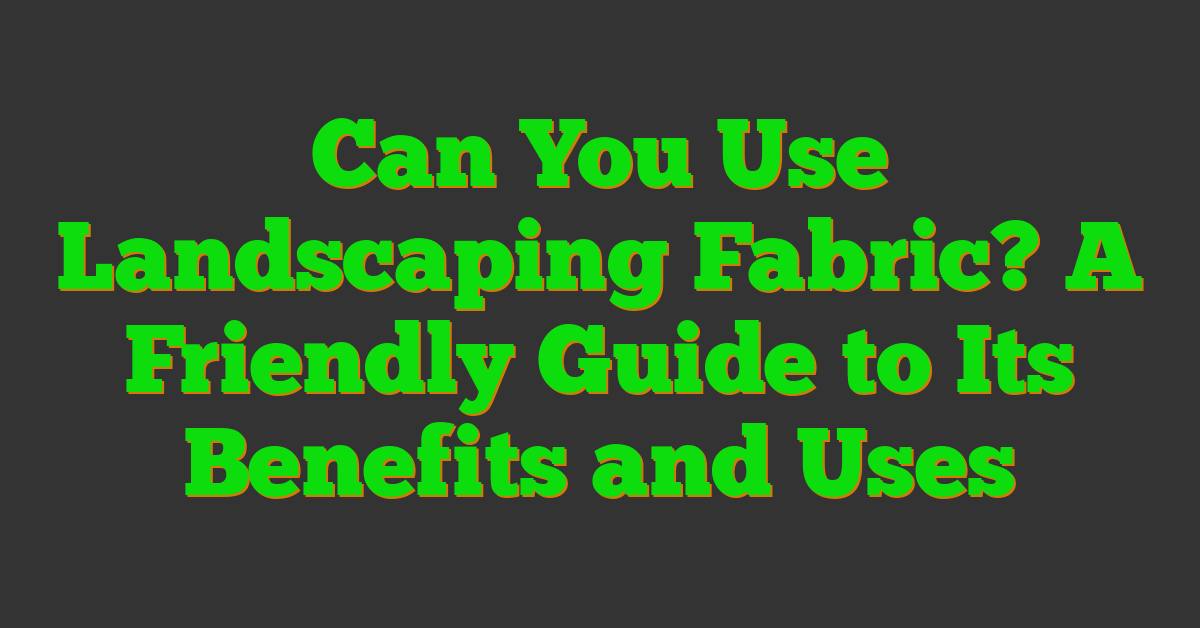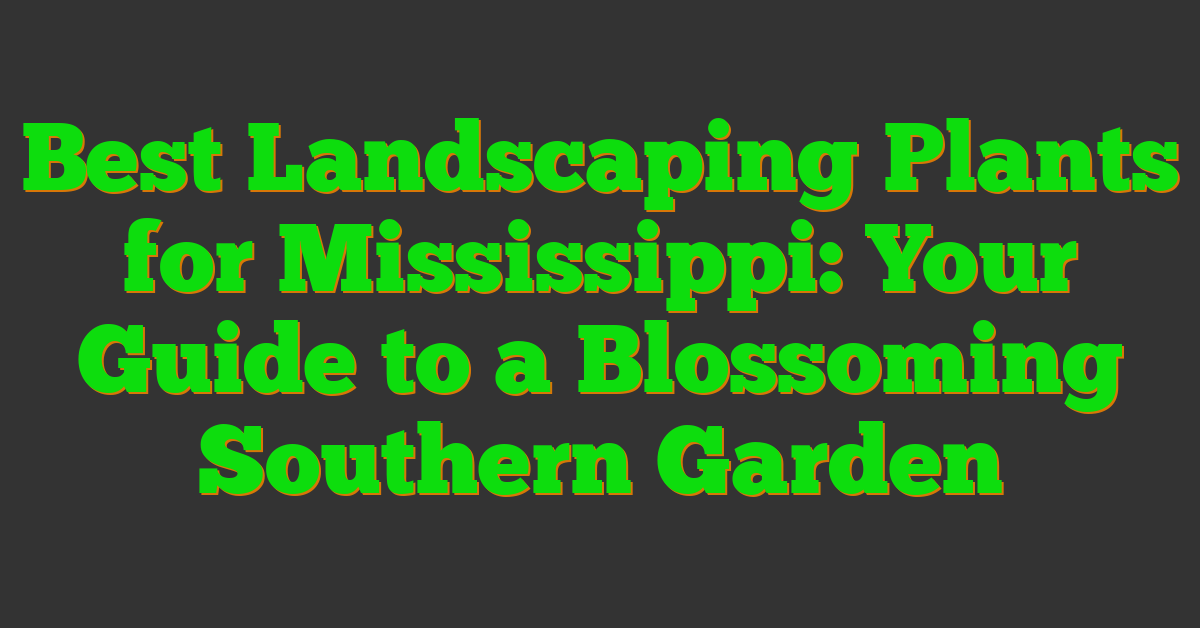If you’re an avid gardener, you know the importance of keeping weeds at bay. While there are many ways to prevent weeds from growing, one popular solution is to use landscape fabric. Landscape fabric is a type of material that is designed to block sunlight and prevent weeds from growing. But can you use landscaping fabric in your garden?
Understanding landscape fabric is essential before deciding whether to use it in your garden. Landscape fabric is typically made from woven or nonwoven materials, and it is designed to allow water and air to pass through while preventing weeds from growing. While landscape fabric can be an effective way to prevent weeds, it’s not always the best solution for every garden.
Before you decide to use landscape fabric in your garden, it’s important to consider the pros and cons. While landscape fabric can help prevent weeds, it can also make it difficult for water and nutrients to reach your plants’ roots. Additionally, landscape fabric can be expensive and difficult to install. Understanding the pros and cons of landscape fabric can help you make an informed decision about whether to use it in your garden.
Key Takeaways
- Landscape fabric can be an effective way to prevent weeds, but it’s not always the best solution for every garden.
- Before using landscape fabric, consider the potential impact on your plants’ health and the long-term maintenance requirements.
- Understanding the pros and cons of landscape fabric can help you make an informed decision about whether to use it in your garden.
Understanding Landscape Fabric

If you’re looking to maintain a healthy and attractive garden, you may have heard of landscape fabric as a potential solution. Landscape fabric is a type of material that can be used to cover soil and provide a variety of benefits. In this section, we’ll take a closer look at landscape fabric and its uses.
Types of Landscape Fabric
There are several different types of landscape fabric available, including woven, spun, and non-woven varieties. Woven landscape fabric is made from polypropylene or polyester and is the most durable type of fabric available. Spun landscape fabric is made from polypropylene and is a good choice for controlling weeds. Non-woven landscape fabric is made from polyester or a blend of polyester and polypropylene and is best used for erosion control.
Benefits of Using Landscape Fabric
Using landscape fabric can provide several benefits for your garden. One of the primary benefits is weed control. Landscape fabric can help prevent weeds from growing in your garden, which can save you time and effort in the long run. Additionally, landscape fabric can help retain moisture in the soil, which can be particularly beneficial in dry climates. Landscape fabric can also help prevent erosion and promote soil health by providing a barrier between the soil and the elements.
Common Misconceptions
There are a few common misconceptions about landscape fabric that are worth addressing. One of the most common misconceptions is that landscape fabric is not environmentally friendly. While some types of landscape fabric may contain chemicals that can harm the environment, there are also organic and inorganic mulches available that can be used as an alternative. Another misconception is that landscape fabric is not effective at controlling weeds. While it’s true that landscape fabric may not be 100% effective at preventing all weeds from growing, it can significantly reduce the number of weeds that grow in your garden.
In summary, landscape fabric can be a useful tool for maintaining a healthy and attractive garden. By understanding the different types of landscape fabric available and the benefits it provides, you can make an informed decision about whether or not to use it in your own garden.
Preparation and Installation
https://www.youtube.com/watch?v=UQoyr7ThwiQ&embed=true
Site Preparation
Before installing landscape fabric, you need to prepare the site properly. Clear the area of all debris, including weeds, rocks, and sticks. To ensure the best results, it is recommended to dig the soil to a depth of at least six inches and add soil amendments if necessary.
Installing Landscape Fabric
Once the site is prepared, you can begin installing the landscape fabric. First, measure the area to determine how much fabric you need. Then, cut the fabric to size, leaving an extra 2-3 inches on all sides to allow for overlap.
Next, lay the fabric over the prepared area, ensuring that it is flat and covers the entire surface. Use landscape pins or staples to secure the fabric in place. Be sure to overlap the edges of the fabric by at least 6 inches to prevent weeds from growing through the seams.
After installing the fabric, you can create holes for planting. Use a utility knife or scissors to make small cuts in the fabric where you want to plant. Be careful not to cut too much fabric, as this can compromise the weed barrier.
Maintenance
While landscape fabric can greatly reduce the amount of weeding needed in your garden beds or flower beds, it is not a foolproof solution. Over time, weeds and grass can still grow on top of the fabric, so it’s important to keep an eye on your garden and remove any unwanted growth.
If you do need to remove the fabric for any reason, simply pull up the pins or staples and lift the fabric away. You can then dispose of the fabric or reuse it in another area of your garden.
Overall, installing landscape fabric can be a great way to reduce maintenance and keep your garden looking its best. With proper site preparation and installation, you can enjoy a beautiful and weed-free garden for years to come.
Optimizing Garden Health
To maintain a healthy garden, it is important to consider various factors such as watering and irrigation, encouraging beneficial organisms, and soil health. Using landscaping fabric can help with weed control, but it is important to ensure that it does not negatively impact the health of your garden.
Watering and Irrigation
Proper watering and irrigation are essential for maintaining healthy plants. When using landscaping fabric, it is important to ensure that water can penetrate the fabric and reach the roots of your plants. You can achieve this by using a drip irrigation system or watering slowly and deeply to allow water to seep through the fabric. It is also important to monitor the soil moisture level regularly to ensure that your plants are receiving the right amount of water.
Encouraging Beneficial Organisms
Beneficial organisms such as earthworms and microorganisms play an important role in maintaining soil health. When using landscaping fabric, it is important to ensure that it does not prevent earthworms from moving among the roots of your plants. You can encourage earthworms by adding organic materials such as compost to your soil. Additionally, using organic mulch on top of the fabric can help to promote the growth of beneficial microorganisms.
In conclusion, using landscaping fabric can be a useful tool for weed control in your garden. However, it is important to ensure that it does not negatively impact the health of your garden. By considering factors such as watering and irrigation, encouraging beneficial organisms, and soil health, you can maintain a healthy and thriving garden.
Additional Landscape Considerations
« What is Landscape Understanding? A Friendly Explanation Best Landscaping for Pine Needles: Tips and Ideas »
When it comes to using landscaping fabric, there are some additional landscape considerations to keep in mind. In this section, we will discuss two important aspects to keep in mind when using landscaping fabric: combining it with other materials and addressing weed growth.
Combining with Other Materials
While landscaping fabric is a great way to prevent weeds from growing in your garden, it is not always the only solution. Combining it with other materials, such as mulch, wood chips, gravel, rock, or stones, can provide additional benefits. Mulch, for example, can help retain moisture in the soil and provide a more attractive appearance to your garden. Gravel, rock, or stones can also provide an attractive appearance while allowing for better drainage.
Addressing Weed Growth
While landscaping fabric can help prevent weeds from growing in your garden, it is not foolproof. Some weeds may still find a way to grow through the fabric or around the edges. To address weed growth, you can use weed control fabric or a pre-emergent herbicide. Weed control fabric is a thicker and more durable fabric that is specifically designed to prevent weeds from growing. A pre-emergent herbicide, on the other hand, is a chemical that is applied to the soil before planting to prevent weeds from germinating.
When using landscaping fabric, it is important to remember that it is not a substitute for proper garden maintenance. Regularly removing any weeds that do manage to grow through the fabric can help prevent them from spreading and taking over your garden. Additionally, it is important to periodically inspect the fabric for any tears or damage that may allow weeds to grow through.
In conclusion, landscaping fabric can be a great addition to your garden when used properly. By combining it with other materials and addressing weed growth, you can create a beautiful and low-maintenance garden that will be the envy of your neighborhood.
Maintenance and Longevity
Routine Maintenance
Once you have installed landscaping fabric, you will need to perform routine maintenance to ensure it continues working effectively. One of the main benefits of using landscaping fabric is that it reduces the amount of weeding required, but it does not completely eliminate it. You will still need to remove any weeds that manage to grow through the fabric.
Another important aspect of routine maintenance is removing any debris that accumulates on top of the fabric. This can include fallen leaves, twigs, and other organic matter. If left unattended, this debris can break down and create a layer of soil on top of the fabric, which can lead to weed growth.
Replacing Landscape Fabric
Although high-quality landscaping fabric can last for many years, it will eventually need to be replaced. The exact lifespan of your fabric will depend on a variety of factors, including the quality of the fabric, the amount of foot traffic it receives, and the climate in your region.
When it comes time to replace your landscaping fabric, you will need to factor in the cost of new fabric, as well as the labor required to remove the old fabric and install the new one. While this may seem like a significant expense, keep in mind that using landscaping fabric can be a cost-effective way to reduce weed growth and minimize the need for reseeding and weeding.
If you are looking for a more environmentally friendly option, consider using biodegradable landscaping fabric. While this type of fabric may not last as long as traditional fabric, it will break down over time and can be a great option for gardeners who are concerned about reducing their impact on the environment.
In summary, routine maintenance is important to ensure the longevity of your landscaping fabric. Although it will eventually need to be replaced, using high-quality fabric can be a cost-effective way to reduce weed growth and minimize the need for labor-intensive weeding and reseeding.
Environmental and Aesthetic Impact
When it comes to using landscaping fabric, there are some important considerations to keep in mind regarding its environmental and aesthetic impact.
Eco-Friendly Alternatives
While landscaping fabric can be an effective way to keep weeds at bay, it is not always the most environmentally friendly option. The fabric can be made from synthetic materials that are not biodegradable, and it can prevent water and nutrients from reaching the soil. This can lead to soil compaction and reduced plant growth.
If you are looking for a more eco-friendly alternative to landscaping fabric, consider using organic mulch instead. Organic mulch, such as shredded leaves, grass clippings, or wood chips, can help suppress weeds while also enriching the soil with nutrients as it breaks down. Other options include cardboard, newspaper, burlap, or pine needles.
Visual Appeal
In addition to its environmental impact, landscaping fabric can also have an impact on the aesthetic of your garden. While it may be effective at controlling weeds, it can also be unattractive and detract from the beauty of your flower garden or ground cover.
If you are concerned about the visual appeal of your garden, you may want to consider using inorganic mulch instead. This can include materials such as rocks, gravel, or pebbles, which can help suppress weeds while also providing a decorative element to your garden. Alternatively, you can use organic mulch that complements the colors and textures of your plants, such as shredded bark or wood chips.
Overall, while landscaping fabric can be an effective way to control weeds, it is important to consider its environmental impact and aesthetic appeal when deciding whether or not to use it in your garden. By exploring eco-friendly alternatives and considering the visual impact, you can create a garden that is both beautiful and environmentally friendly.
Choosing the Right Fabric for Your Garden
https://www.youtube.com/watch?v=v8cqR6nXjXs&embed=true
When it comes to choosing the right landscape fabric for your garden, there are a few things to consider. First, you need to decide what type of plants you will be growing in your garden. Different plants have different needs, and some may not be compatible with landscape fabric.
Vegetable Gardens and Annuals
If you are growing vegetables or annuals, you will want to choose a landscape fabric that allows water and nutrients to pass through. This will ensure that your plants receive the necessary moisture and nutrients they need to grow. A permeable fabric is also important for vegetable gardens because it allows air to circulate around the plants, which can help prevent fungal diseases.
When choosing a landscape fabric for your vegetable garden, look for a product that is specifically designed for this purpose. These fabrics are usually made from lightweight materials that are easy to work with and allow for good air and water flow.
Perennial and Decorative Beds
If you are planting perennials or decorative plants, you may want to choose a heavier landscape fabric that is designed to suppress weeds. These fabrics are usually made from a thicker material that can withstand the weight of heavier plants and won’t tear easily.
When choosing a landscape fabric for your perennial or decorative beds, look for a product that is designed to be used in flower beds. These fabrics are usually heavier and more durable than those used in vegetable gardens.
No matter what type of landscape fabric you choose, be sure to follow the manufacturer’s instructions for installation and maintenance. Proper installation will ensure that your landscape fabric works effectively to keep weeds at bay while still allowing your plants to thrive.
Professional Tips and Tricks
https://www.youtube.com/watch?v=Yd3F-9rWLu0&embed=true
If you are considering using landscape fabric in your garden or yard, there are a few professional tips and tricks that you should keep in mind to ensure that your installation is successful and long-lasting. Here are some expert tips to help you get the most out of your landscape fabric:
Expert Installation Advice
- Prepare the soil: Before you install landscape fabric, you should prepare the soil by removing any weeds or debris. This will help to ensure that the fabric lays flat and is not damaged by sharp objects.
- Use fabric staples: To secure the landscape fabric in place, use fabric staples every 10 feet or so along the edges and seams. A hammer or small hand maul can be used to strike each fabric staple.
- Weigh down the fabric: To prevent the fabric from moving or shifting, use stones or heavy objects to weigh it down. This will help to keep the fabric in place and prevent it from being lifted by wind or water.
Long-Term Landscape Planning
- Consider erosion control: Landscape fabric can be an effective tool for controlling soil erosion. It helps to prevent soil from washing away during heavy rain or wind.
- Weed control: Landscape fabric can also be used to control weeds. By preventing sunlight from reaching the soil, it can help to prevent weed growth.
- Maintenance: While landscape fabric can be a useful tool, it does require some maintenance. Over time, the fabric can become clogged with dirt and debris, which can reduce its effectiveness. To keep your landscape fabric in good condition, it is important to regularly remove any debris and clean the fabric as needed.
By following these professional tips and tricks, you can install landscape fabric that is effective, long-lasting, and easy to maintain. Whether you are a landscaping professional or a DIY enthusiast, these tips can help you get the most out of your landscape fabric installation.
Cost Considerations and Budgeting
When it comes to using landscaping fabric, one of the most important considerations is the cost. Before you start your project, it’s essential to calculate your costs and set a budget. This will help you avoid overspending and ensure that you get the most cost-effective solution for your needs.
Calculating Project Costs
To calculate your project costs, you’ll need to consider several factors. These include the size of your project, the type of fabric you choose, the number of landscape pins you’ll need, and any other materials you’ll need to purchase.
When it comes to landscape fabric, synthetic options are generally more cost-effective than organic options. While organic fabrics are more environmentally friendly, synthetic fabrics are more durable and long-lasting. Additionally, synthetic fabrics are typically less expensive than organic options.
You’ll also need to consider the cost of landscape pins or metal pins to secure the fabric in place. The number of pins you’ll need will depend on the size of your project and the type of fabric you choose. Generally, metal pins are more expensive than landscape pins, but they’re also more durable and long-lasting.
Balancing Cost and Quality
While it’s important to consider cost when choosing landscaping fabric, it’s also essential to balance cost and quality. Choosing a low-quality fabric may save you money in the short term, but it may also result in higher long-term costs due to the need for frequent replacements.
When choosing a fabric, look for options that offer the right balance of quality and cost-effectiveness. Synthetic fabrics are typically a good choice, as they’re both durable and cost-effective. Additionally, look for fabrics that offer good weed control and act as an effective weed barrier.
Overall, by carefully considering your costs and balancing cost and quality, you can choose the right landscaping fabric for your needs without overspending.
Frequently Asked Questions
Is it necessary to remove turf before laying down landscape fabric?
When using landscape fabric, it is generally recommended to remove existing turf or grass before installation. This helps ensure that the fabric lies flat and provides effective weed control.
What are the best types of landscape fabric for different gardening projects?
The best type of landscape fabric for your project depends on factors such as the soil type, climate, and intended use. Non-woven landscape fabric is suitable for general weed control, while woven fabric may be more durable for areas with heavy foot traffic.
Can you install landscape fabric around plants that are already established?
Yes, you can install landscape fabric around established plants. Carefully cut and arrange the fabric around the plants, allowing for proper airflow and ensuring that the fabric does not constrict the growth of the plants.
What materials are commonly used in the production of landscape fabric?
Landscape fabric is typically made from synthetic materials such as polypropylene or polyester. These materials are chosen for their durability, resistance to UV rays, and permeability to water and air.
Are there any effective alternatives to landscape fabric for use beneath gravel?
One effective alternative to landscape fabric for use beneath gravel is using a layer of geotextile fabric. This material allows for water drainage while preventing weed growth, providing a similar function to landscape fabric.
Should landscape fabric be used in a vegetable garden, and if so, how?
Landscape fabric can be used in a vegetable garden to help suppress weeds and conserve soil moisture. It should be installed with proper spacing between plants and can be covered with organic mulch to maintain a healthy growing environment.
























